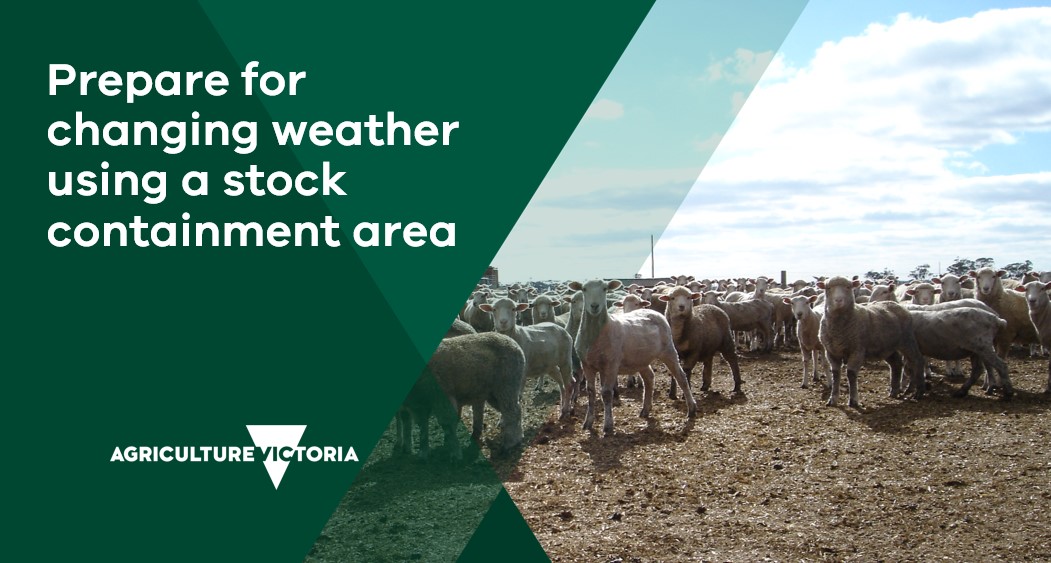To feed or not to feed – that is the question
Article printed April 18, 2024. For the latest version, please go to: https://feedinglivestock.vic.gov.au/2021/11/01/to-feed-or-not-to-feed-that-is-the-question/
With high stock prices and a favourable grain harvest looking likely is a temptation to run a percentage of lambs through on grain for earlier turnoff or for sale at heavier weights. Before a single kilogram of grain is fed out to the weaners, it is well worth running through some costings and budgets and thinking about what management can be done now to set up for future success. An estimated budget is essential – in many cases selling as store lambs may be the more profitable option. The budget will include the ration cost and buy/sell price of lambs and especially the estimated growth rates that lambs are likely to achieve, as well as other running costs such as shearing/crutching, animal health costs and losses as shy feeders/low growth rates, etc. Feeding lambs where you are 100 per cent responsible for daily needs is labour intensive so you would want to ensure a good return before jumping in.
In this article we will run through a useful feedlot calculator and look at some of the factors that will help ensure that the lambs perform to their potential.
When targeting feedlot performance people will often focus on having lambs enter with as much weight as possible. The reality is that in many cases heavier isn’t always better, and often there is no real relationship between starting weight and overall feedlot performance.
To a certain extent, the poor performance of heavy lambs (e.g., 45 kg and heavier) when they get into the feedlot can be explained by the maturity pattern. These heavy lambs have already ‘run their race’ they have laid down their bone, muscle and have probably started to lay down fat. The impacts are twofold to the feedlotter: 1) growth will have started to flatten out (think of a standard growth curve, it has to plateau somewhere – and in this case we are nearing or past the plateau) and 2) if the lambs have already started to lay down fat, this comes at a high energy cost. Therefore, highly muscled lean lambs are more efficient than low muscled fatter lambs. In the high feed cost environment of a feedlot, depositing excess fat is expensive. So, the implications of feeding heavier lambs are twofold – growth rates are already slowing, and the cost to deposit every extra kilogram of liveweight – which is made up of an increasing proportion of fat – has increased.
However, even at the lighter weights (such as 35 kg, often considered an ‘ideal’ weight for feeding lambs) there will be a large variation in feedlot performance. Some will have excellent growth rates, while others will be a certainty to underperform and lose money. While genetics obviously plays a part, there are other causes of variation. For example, a 35 kg lamb at feedlot entry that was born in the first week of lambing as a single, is vastly different from a 35 kg lamb that was born on the last day of lambing and raised as a twin. One has plenty of growth potential and is gaining weight at an impressive rate, while the other has been very pedestrian in comparison. So, two similar liveweight lambs can have quite different growth potential. Not to mention other factors that impact on growth rates, such as diseases and feed issues.
The challenge to the feedlotter is to identify which lambs, irrespective of starting weight, are going to be the ones that will perform well in the feedlot.
Figure 1 shows results from a group of commercially finished lambs and presents the relationship between weight gain over the finishing period and how the lambs performed in the first two weeks. Of the lambs that gained 15 kg plus while on feed – all of those lambs put on a minimum of 2.5 kg in the first two weeks of feedlot life (circled in red). This observation is supported by the overall trend whereby lambs that do well in the first two weeks in the feedlot are the ones that do the best over the duration of finishing. From the same dataset – it can be seen that lambs than have zero weight gain in the first two weeks are unlikely to have a change of fortune and yield a favourable result by the end of the time on feed.
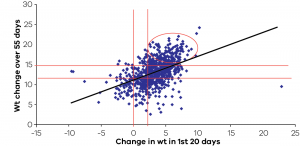
Figure 1: Weight change of lambs in a feedlot trial as a change in weight in the first 20 days versus weight change over 55 days.
The messages from this are clear. It is imperative that when a lamb enters the feedlot, they need to hit the ground running. All management before and around feedlot induction needs to be centred around getting lambs up to the troughs and eating. Lambs need to have been exposed to the principal ingredients in the ration before entering the feedlot – if they are being finished on barley and lupins, then they need to be ‘imprinted’ to these ingredients well before they enter the feedlot. Furthermore, shy feeders that aren’t adapting to the feedlot environment are best treated differently, such as a good pasture or a separate pen with greater access to the feed.
To help in the calculations of whether finishing lambs within a feedlot operation is worthwhile (and selecting lambs that perform the best as above), the NSW Department of Primary Industries has a good excel based feedlot calculator. This is accessible on the Feeding Livestock website in the Sheep Tools section and can be downloaded onto your computer. Here, we walk through the basic calculator and some of the issues that are considered. There is an Advanced version which gives more options for developing rations and feedlot notes that can also be downloaded.
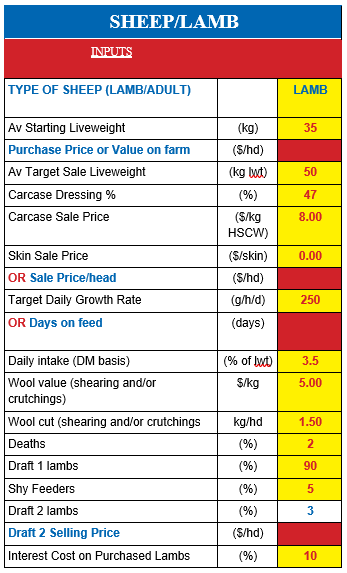
Figure 2: shows all the variables that need to be entered such as an estimate of the buy and sell price of the lambs, the wool value (if shorn and not included in the buy in value) and critically the growth rate you think is realistic (based on how much ration they consume and the feed conversion ratio). Many of these entry boxes provide a drop-down guide, when you click on the cell, as to how to make an estimate, however it is still important that you ‘test’ the provided estimates against what you lambs may have done in the past. For example, carcase dressing percentage will vary depending on fat score, breed, season etc and some adjustments for these are provided if you don’t know how your stock will perform. Similarly, guides are provided for daily intake (as a percentage of live weight). You can use either carcase sale price (as dollars per kilogram of hot standard carcase weight plus wool value) or you can just use a price per head.
In this example we are feeding lambs with a starting rate of 35 kg live weight and valued them at $180 per head. We are aiming for a sale weight of 50 kg live weight and estimated dressing percentage of 47 per cent. We have estimated a growth rate of 250 g/head/day and this would be equivalent to a feed conversion ratio of six (kg of feed eaten as dry matter per kg of liveweight), which is a realistic figure to use (see Figure 8). Figure 6 shows all the running costs of the feedlot such as animal health; crutching/shearing; transport; killing costs etc. The ration cost is estimated when you enter the components of the ration and the cost per tonne and dry matter percentage (Figure 7). In this example, the ration is a basis of wheat and lupins with hay for roughage, bentonite as a buffer and lime and salt for calcium and sodium. The total ration cost (here it is $295/tonne as fed) is therefore estimated based on the dry matter and the proportion of each in the feed.
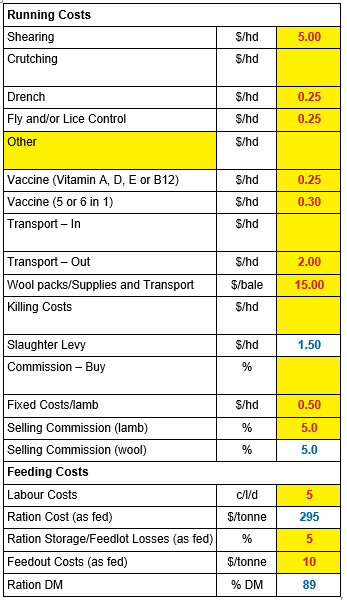
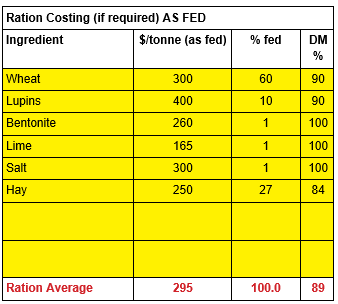
The output table (Figure 8) shows the total estimated costs and income per lamb You can see that whilst the ration cost is significant (at $32.20 per lamb) running, fixed and selling costs all add to the overall costs and, in this scenario, the profit when ALL costs are taken into account is only $2.87 per lamb. So, the true cost will be even higher if the lambs aren’t growing as well as you have estimated (due to causes such as poor induction to the ration before finishing or poor genetics)
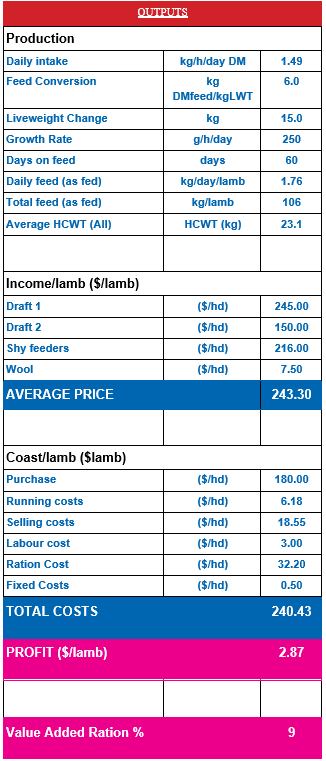
All that aside, the calculator is a great tool to use to assess the profitability of finishing under different conditions – in the above scenario the finishing was marginal at best, but if store lamb prices had been $145, then the outcome would have been very different. Similarly, you can use the calculator to assess what growth rates versus ration cost are needed to be profitable, for example the required growth rate to be profitable when feeding a $300 home grown ration versus feeding a $400 commercial pellet will be very different (but make sure you account for extra time). The feedlot calculator provides a great opportunity to cost different inputs as well as giving you some valuable guides and resources to help you on the way.

